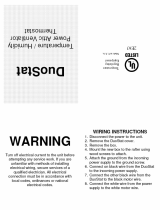
Impinger I – 1400 Series Advantage Service Manual – Dom & Int’l
19
Temperature Control Board Check for 120 VAC input to temperature control
board. If not present, check wiring from Hi-Limit to
temperature control board. Turn the temperature
adjustment dial to the maximum temperature position.
Check for 120 VAC at coil of mercury contactor(s).
Next, short the leads of thermocouple on the
temperature control board, check for 120 VAC at coil
of mercury contactor(s). If voltage is not present,
replace temperature control board. If voltage is
present, proceed.
Thermocouple Probe Remove thermocouple leads from the temperature
control board, and measure the millivolt output of the
leads. Refer to chart (page 25) in adjustment section
for proper millivolt readings.
Mercury Contactor(s) Check for 120 VAC to the contactor coil. If voltage is
present and contactor will not activate, replace the
contactor(s). Also check each contactor for proper
high voltage input and output.
50 Amp Fuses If there is no high voltage input to the mercury
contactor(s), check the 50 amp fuses and replace if
necessary.
Heater Elements Check the Amp. draw on each hot leg for proper load.
Check the specification plate for rating information. If
the Amp. draw is low or high, check the individual
elements for opens, shorts, and proper resistance. To
check resistance of the elements, turn off the power!
Remove all leads from the elements and use an
accurate digital VOM. The element resistance should
be as follows: 208V - 9.8 ohms approx. 220V - 10.5
ohms approx. 240V - 13 ohms approx. If all readings
are not correct, replace elements as needed.
Oven heats with
switch off
Mercury Contactor(s) The mercury contactor has probably malfunctioned in
the closed position. If there is no voltage to the
operating coil, but there is high voltage at the
contactor output, replace the mercury contactor.
Voltage Supply (Export Ovens) Check incoming voltage supply, check breakers and
reset if required. For some export ovens there is a
control circuit step down transformer. This transformer
steps down supply voltage to 120 VAC. If conveyor
will not run, the secondary of this transformer must be
checked for 120 VAC output. Check specific oven
model schematic for circuit location.
Speed Adjustment
Potentiometer
This is a 0 to 10K ohm, 1 turn potentiometer. With
power off, remove the black and white pot leads from
the motor control board at terminals P1 and P2 with a
digital multimeter, check the ohm reading on the black
lead (P2) and the white lead (P1). Rotating the pot,
slowly, from low to high, the meter reading should
show an even transition from 0 to 10K ohms ± 5%.
There should be no dead or open spots through out
the 1 turn of the pot. Check both leads to
ground.There should be no continuity to ground. If any
of the above checks fail, replace the pot.
Conveyor will not run
DC Motor Control Board Check for 120 VAC input to the control board at
terminals L1 and L2.If not present, check back to
power source if necessary. If 120 VAC is present at L1
and L2, check the VDC output at terminals A+ and A-.
If 120 VAC is present at terminals L1 and L2, but DC
voltage is not present at A+ and A-, verify fuses are
not blown, if fuses check ok, replace the board. If DC
voltage is present at A+ and A-, but motor does not
run, check gear motor as follows:




























